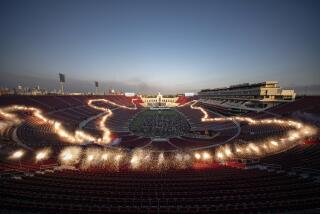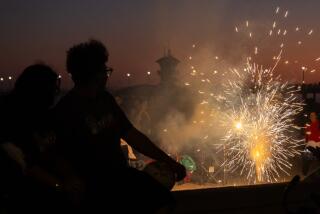Fillmore Fireworks Policy Boon to Some, Thorn to Others
FILLMORE — Shortly before sundown on the first day of fireworks sales here, Stephanie Winter and two of her three children peruse the Rotary Club’s booth in the McDonald’s parking lot.
Her 4-year-old daughter saw the colorful booths scattered along California 126 and begged her mother to stop.
“Mommy, mommy, can we please get these?” she said, tugging at Winter’s arm and pointing toward packs of sparklers and Monster Snaps.
Winter gives in.
But, she said, “I don’t like fireworks.”
Neither do state and local fire officials.
“They’re a thorn in our side,” said Joe Luna, spokesman for the Ventura County Fire Department. He added that he wished no city allowed fireworks sales and said Fillmore’s policy causes problems.
“It puts people in harm’s way,” he said.
Only in Fillmore can drivers have such impulse buys; it’s the only city in the county that sells fireworks in the week before July 4. And buyers are only supposed to light them within city limits, because they are illegal everywhere else in the county.
In California, 158 cities--34 of them in Los Angeles County--sell “safe and sane” fireworks.
“It’s up to each jurisdiction to be restrictive or ban them,” said Diane Arend, a deputy state fire marshal in the fireworks division. “We’ve had regulations for many years and only approve those tested and approved as safe and sane.”
Still, said Brian Remsen, a 31-year-old truck driver from Ventura, it’s a silly law.
“If you’re on a residential street where there are no weeds, what’s the big deal?” he asked.
When it comes to fires and California, fireworks have been a very big deal.
For instance, in December two Ojai teens playing with fireworks caused a 4,300-acre fire that took nearly 1,600 firefighters working through the Christmas holiday to extinguish. Officials estimated the fire, which burned down a home and destroyed forest land, caused $5 million in damages.
This year, fire season began in mid-May and already there have been several blazes.
Although none was caused by errant fireworks, Luna said, winter rains caused a spurt of new grass that has since dried out and is ready to burn.
According to the state fire marshal’s office, 92% of California’s fire losses come from illegal fireworks.
A 1992 study indicated 466 fires and $1.6 million in property loss as a result of both “safe and sane” and illegal fireworks.
There’s an alarming trend toward buying outlaw fireworks off the Internet, Arend said.
The nonflying fireworks approved by the state are supposed to lessen the possibility of fires, she said.
“We’re probably the most restrictive state. We don’t allow anything that hops, explodes or rises into the air,” Arend said.
Sometimes, even safe and sane fireworks go awry, said Brad Smith, a San Fernando Valley man buying fireworks with coupons from the Internet.
“I’ve seen safe and sane fireworks explode,” he said, motioning toward a pack of Ground Blooms. “They go off like an M-80 when they’re defective. Some of these carefully controlled and monitored stuff can get pretty wild.”
Two fireworks-related injuries were reported in the county last year, according to a 1999 state fire marshal’s report.
One came from illegal fireworks such as cherry bombs and Roman candles, the another from an unknown source.
Just over the line in Los Angeles County, those injury numbers are much higher, according to the same report.
Safe and sane fireworks caused 69 injuries, 19 from legal fireworks, 24 from illegal ones and 26 from unknown sources, the report showed.
Nationwide, 8,500 people were treated for fireworks injuries last year, 40% of them children under 15, according to statistics provided by county fire officials.
Vendors at the casino-style booths in Fillmore, however, say high-powered fireworks such as M-80s and bottle rockets start fires and cause injuries, and that those fireworks are not sold in Fillmore.
Much of the fireworks sold in Fillmore are by organizations that use the sales to raise money.
Vendors opened at noon Wednesday and won’t close until lunchtime next Wednesday. The longer they are open, the more money they will raise for their organizations.
It’s a big-time fund-raiser, supporting everything from scholarships to Habitat for Humanity, said Pam Garcia, a volunteer at the 4-H fireworks booth.
Her club raised $12,000 from fireworks sales last year.
A man in a Hawaiian shirt approaches the 4-H booth and studies the stock.
He pokes his head through the booth’s wire mesh opening and makes a special request.
“Where are the ones you put on the ground that go whiz?” he asks, stirring the air with his finger and making a kazoo sound.
“You can call me Jack,” he jokes, refusing to reveal his name. “You know, like Jack-in-the-Box.”
Garcia leans over and whispers, “They don’t want people to know they engage in this activity.”
Jack isn’t from Fillmore and doesn’t want anyone to know his Fourth of July plans include tinkering with $138 worth of pyrotechnic fountains.
More to Read
Sign up for Essential California
The most important California stories and recommendations in your inbox every morning.
You may occasionally receive promotional content from the Los Angeles Times.










